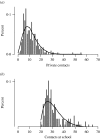Social contacts of school children and the transmission of respiratory-spread pathogens
- PMID: 17634160
- PMCID: PMC2870867
- DOI: 10.1017/S0950268807009181
Social contacts of school children and the transmission of respiratory-spread pathogens
Abstract
Empirical data about contact frequencies of children is needed for estimating parameters in mathematical modelling studies that investigate the effect of targeting influenza intervention to children. A survey about the social contacts of school children was conducted in a primary school in Germany. The distribution of the daily numbers of contacts was stratified by age of the contacted person and by weekday. A negative binomial regression analysis was performed to investigate factors that influence contact behaviour. Using logistic regression analysis we examined the relationship between the numbers of private contacts and having been ill in the last 6 months. We computed effective contact numbers to take the heterogeneity in contact behaviour into account in assessing the contribution of children's contacts to the overall transmission of an infection. The possible effects of intervention measures such as school closure and vaccination on the transmission of respiratory-spread agents to other age groups are discussed.
Figures




References
Publication types
MeSH terms
LinkOut - more resources
Full Text Sources

